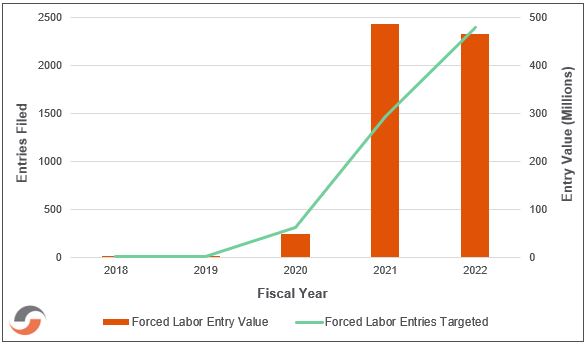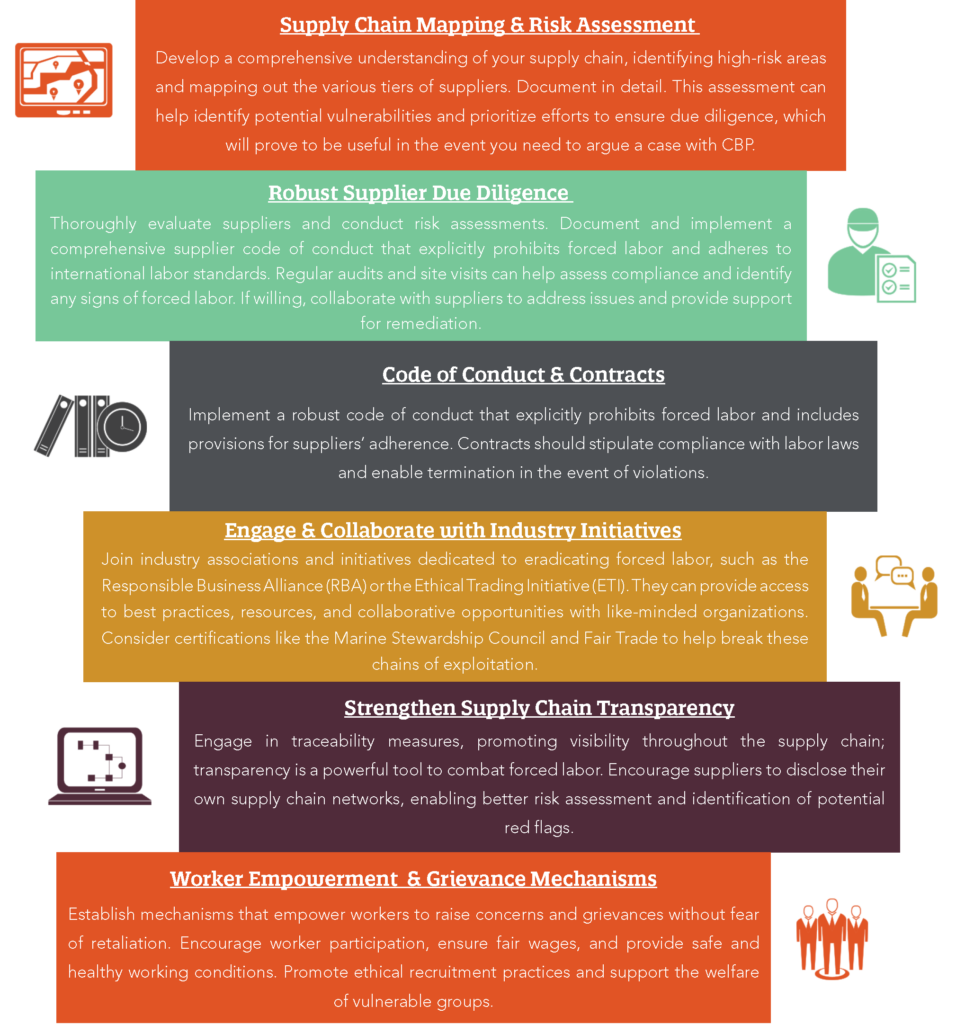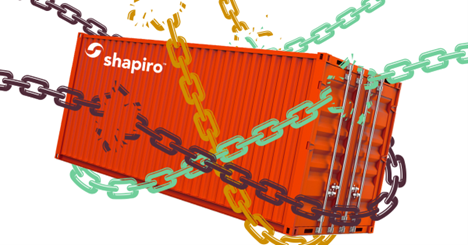Uyghur Forced Labor Prevention Act (UFLPA)

We know what you’re thinking…not another football league spinoff. Fear not because the UFLPA takes on a much more heroic role in our society. Forced labor generates an estimated $150 billion (USD) in profits annually and affects over 27 million laborers (about the population of Texas). The hero wrapped in a red cape here to save millions of laborers is none other than the Uyghur Forced Labor Prevention Act.
The UFLPA is intended to address and counter forced labor and human rights violations in the Xinjiang Uygur Region of China, where there have been reports of mass arbitrary detention, forced labor, and other human rights abuses against Uyghurs and other ethnic minority groups.
The act proposes several measures to combat forced labor and ensure that goods produced using forced labor in the XUAR are not allowed into the United States. Some of the key provisions may include:
- Import Restrictions: The act may require the U.S. Customs and Border Protection to enforce restrictions on imports of goods that are produced in whole or in part using forced labor in the XUAR. This is aimed at preventing such goods from entering the U.S. market.
- Public Disclosures: Companies that do business in or with the XUAR may be required to disclose information about their supply chains to ensure transparency and identify any potential involvement in forced labor practices.
- Export Controls: The act may enable the U.S. government to impose export controls on technologies and goods that could be used in surveillance and repression in the XUAR.
- Sanctions: The UFLPA may empower the U.S. government to impose sanctions on individuals, entities, and officials involved in human rights abuses and forced labor practices in the XUAR.
It’s important to note that the specifics of the UFLPA may vary depending on the version and amendments of the legislation. You can also view our UFLPA resources.
UFLPA Enforcement Stats

The act has received increasing attention in previous years with the number of entries targeted—since 2020 alone, the entries have catapulted by a whopping 500%. But, it’s not without good reason, as championing these fair labor practices aligns with a future in which every worker is treated with dignity and respect.
UFLPA Updates
View UFLPA Updates
| Date | Details | |
| 08/01/2023 | The Forced Labor Enforcement Task Force (FLETF) has published an updated UFLPA Strategy to Prevent the Importation of Goods Mined, Produced, or Manufactured with Forced Labor in the People’s Republic of China. | |
| 12/11/2023 | Three new China – Based Companies added to Uyghur List The DHS (Department of Homeland Security) announced on Dec. 8 the addition of three China-based companies to the Uyghur Forced labor Prevention Act (UFLPA). The total number of restricted companies is now 30. Effective Dec. 11, goods produced by COFCO Sugar Holding Co. Ltd, Sichuan Jingweida Technology Group Co., Ltd, and the Anhui Xinya New Materials Co., Ltd will be restricted from entering the United States. The UFLPA, signed into law by President Biden in Dec. 2021, prohibits goods from being imported into the U.S. that are either produced in Xinjiang, or by entities identified on the UFLPA Entity List, unless the CBP determines that the goods were not produced with forced labor. CBP began enforcing the UFLPA in June 2022 and since then, the agency has reviewed more than 6,000 shipments valued at more than $2 billion. | |
Best Practices for Combating Forced Labor
Want to take these tips with you? Just fill out our Forced Labor form and download this free guide to stay on the right side of the fight against forced labor!

Withhold Release Orders (WROs)
Forced Labor Violations have really come to light in the last several years. A Withhold Release Order is issued by the respective commissioner to prevent goods being made with forced labor from entering the U.S. Commerce. To learn more about Forced Labor, check out our blog.
WROs instruct Customs Officers to prevent imports from entering the U.S. due to “reasonable but not conclusive” evidence that forced labor was used in the overseas production of goods. Think Civil vs. Criminal cases when it comes to court – they have completely different standards of guilt. This is very important for manufacturers to be aware of as even the materials used in production could cause an issue.
For example, if you purchase leather made as a result of forced labor and use it for the production of purses, you could be on the hook due to the origin of said leather!
China
China | |||||
|---|---|---|---|---|---|
| # | Date | Merchandise | Entities | Status | Status Notes |
| 35 | 06/23/2021 | Silica-based products | Hoshine Silicon Industry Co. Ltd. and Subsidiaries | Active | Reference Hoshine Frequently Asked Questions | Press Release |
| 34 | 01/13/2021 | Cotton, Tomatoes, and Downstream Products | Xinjiang Uyghur Autonomous Region (XUAR) | Active | Reference XUAR Frequently Asked Questions | Press Release |
| 33 | 11/30/2020 | Cotton and Cotton Products | Xinjiang Production and Construction Corporation (XPCC) and its subordinates | Active | Press Release |
| 32 | 9/8/2020 | Computer Parts | Hefei Bitland Information Technology Co., Ltd. | Active | Press Release |
| 31 | 9/8/2020 | Cotton and Processed Cotton | Xinjiang Junggar Cotton and Linen Co., Ltd. | Active | Press Release |
| 30 | 9/3/2020 | Apparel | Yili Zhuowan Garment Manufacturing Co., Ltd. and Baoding LYSZD Trade and Business Co., Ltd. | Active | Press Release |
| 29 | 8/25/2020 | All Products | No. 4 Vocational Skills Education Training Center (VSETC) | Active | Press Release |
| 28 | 8/25/2020 | Hair Products | Lop County Hair Product Industrial Park | Active | Press Release |
| 27 | 8/11/2020 | Garments | Hero Vast Group | Active | Press Release |
| 26 | 6/17/2020 | Hair Products | Lop County Meixin Hair Products Co., Ltd. | Active | Press Release |
| 25 | 5/1/2020 | Hair Products | Hetian Haolin Hair Accessories Co., Ltd. | Active | Press Release |
| 24 | 9/30/2019 | All Garments | Hetian Taida Apparel Co., Ltd. | Active | Press Release |
| 23 | 3/5/2018 | All Products | Huizhou Mink Industrial CO. LTD. | Active | |
| 22 | 9/16/2016 | Peeled Garlic | Hongchang Fruits & Vegetable Products Co., Ltd. | Active | |
| 21 | 5/20/2016 | Stevia and its Derivatives | Inner Mongolia Hengzheng Group Baoanzhao Agricultural and Trade LLC | Active | |
| 20 | 3/29/2016 | Soda Ash, Calcium Chloride, and Caustic Soda | Tangshan Sanyou Group and its Subsidiaries | Partially Active | <10/12/2016 CBP removed viscose/rayon fiber from the order |
| 19 | 10/6/1995 | Malleable Iron Pipe Fittings | Tianjin Malleable Iron Factory, a/k/a Tianjin Tongbao Fittings Company, a/k/a Tianjin No. 2 Malleable Iron Plant, a/k/a Tianjin Secondary Mugging Factory, a/k/a Tianjin No. 2 Prison | Active | See China Finding below. |
| 18 | 4/27/1995 | Tea | Nanhu Tree Farm, Zhejiang Sanmei Tea Co., Ltd.; Imaizumi Tea Manufacturing & Trading Co., Ltd. (of Nagoya, Japan) | Active | |
| 17 | 12/21/1994 | Artificial Flowers | Guangzhou No. 1 Reeducation-Through-Labor Camp, a/k/a Guangdong Province No. 1 Reeducation-Through-Labor Camp; Kwong Ngai Industrial Company | Active | |
| 16 | 9/3/1993 | Rubber Vulcanization Accelerators | Shenyang Xinsheng (New Life) Chemical Works, a/k/a Shenyang Dongbei Assistant Agent Main Factory, a/k/a Xinsheng Chemical Factory, a/k/a Shenyang No. 1 Laogai Detachment, a/k/a Shenyang Reform Through Labor Second Reform Division | Active | |
| 15 | 9/1/1993 | Rubber Gloves, Condoms, Rubber Raincoats, and Rubber Footwear | Shenyang New Life Rubber Factory, a/k/a Shenyang Xingsheng (or Xinsheng) (New Life) Rubber Plant, a/k/a Shenyang No. 2 Laogai Detachment, a/k/a Shenyang Dabei Prison, a/k/a Shenyang Model Prison | Active | |
| 14 | 8/6/1993 | Hoists | Wuyi Machinery Plant, a/k/a Zhejiang Light Duty Lifting Machinery Factory China, a/k/a Zhejiang Province No. 1 Prison | Active | |
| 13 | 7/8/1993 | Hoists | Wulin (or Wuling) Machinery Works, a/k/a Hangzhou Wulin Machinery Plant, a/k/a Hangzhou Wulin Machinery Works, a/k/a Zhejiang Province No. 4 Prison | Active | |
| 12 | 8/14/1992 | Asbestos | Hsin Kang Asbestos Mine, a/k/a Sichuan (Szechuan) Pin Chiang Enterprise Company | Active | |
| 11 | 8/3/1992 | Electric Fans and Zinc-Coated Wire | Sichuan (Szechuan) Xinsheng (New Life) Labor Factory, a/k/a Xinsheng (New Life) Labor Factory | Active | |
| 10 | 7/17/1992 | Sulfuric (Sulphuric) Acid | Da Wei Chemical Factory | Active | |
| 9 | 7/15/1992 | Drilling Machines | Zi Gong Machinery Factory, a/k/a Zigong Machinery Factory, a/k/a Sichuan (Szechuan) Zigong Labor Reform Detachment | Active | |
| 8 | 7/15/1992 | Auto Parts and Machinery | Ya An Auto Parts Factory, a/k/a Sichuan (Szechuan) Bin-Jiang Enterprises Company | Active | |
| 7 | 6/26/1992 | Tea | Miao Chi Tea Farm | Active | |
| 6 | 6/26/1992 | Cast Iron Items | Wang Tsang Coal and Iron Factory | Active | |
| 5 | 5/22/1992 | Sheepskin and Leather | Qinghai Hide & Garment Factory, a/k/a Qinghai Leather and Wool Bedding and Garment Factory, a/k/a Qinghai Fur and Cloth Factory | Active | See China Finding below. |
| 4 | 2/25/1992 | Galvanized Pipe | Shandong Laiyang Heavy Duty Machinery Factory | Active | |
| 3 | 12/2/1991 | Machine Presses | Xuzhou Forging and Pressing Machine Works | Active | See China Finding below. |
| 2 | 11/14/1991 | Diesel Engines | Yunnan Machinery, a/k/a Golden Horse (JinMa) Diesel Factory, a/k/a Yunnan 1st Prison | Active | See China Finding below. |
| 1 | 11/6/1991 | Planing Machines | Xiang-Yang Machinery Plant | Active | |
Democratic Republic of the Congo
| Democratic Republic of the Congo | |||||
|---|---|---|---|---|---|
| # | Date | Merchandise | Entities | Status | Status Notes |
| 1 | 9/30/2019 | Gold | Artisanal Small Mines | Partially Active | 5/28/2023 CBP has removed ASM DRC gold imported by the Chambers Federations from the order. |
Dominican Republic
| Dominican Republic | |||||
|---|---|---|---|---|---|
| # | Date | Merchandise | Entities | Status | Status Notes |
| 1 | 11/23/2022 | Raw sugar and sugar-based products | Central Romana Corporation Limited | Active | Press Release |
India
| India | |||||
|---|---|---|---|---|---|
| # | Date | Merchandise | Entities | Status | Status Notes |
| 1 | 11/23/1999 | Beedie Cigarettes and Other Tobacco Products | Mangalore Ganesh Beedie Works | Active | Press Release |
| 2 | 07/29/2022 | Garments | Natchi Apparel (P) Ltd. | Inactive | 09/07/2022: CBP marks order as inactive |
Japan
| Japan | |||||
|---|---|---|---|---|---|
| # | Date | Merchandise | Entities | Status | Status Notes |
| 1 | 06/12/1994 | Video Games and Connector Plugs Thereof | Fuchu Prison; Union Kogyo Co., Ltd. | Active | Press Release |
Malawi
| Malawi | |||||
|---|---|---|---|---|---|
| # | Date | Merchandise | Entities | Status | Status Notes |
| 1 | 11/1/2019 | Tobacco | Tobacco produced in Malawi and products containing tobacco produced in Malawi | Partially Active | CBP has removed tobacco and products containing tobacco produced in Malawi from the order that are produced by the following:
|
Malaysia
| Malaysia | |||||
|---|---|---|---|---|---|
| # | Date | Merchandise | Entities | Status | Status Notes |
| 6 | 1/28/2022 | Disposable Gloves | YTY Industry Holdings Sdn Bhd (YTY Group), including YTY Industry Sdn Bhd, Green Prospect Sdn Bhd, and GP Lumut | Inactive | Inactive by Memo from Commissioner dated 02/08/2023. Press Release |
| 5 | 12/20/2021 | Disposable Gloves | Brightway Holdings Sdn Bhd, Laglove (M) Sdn Bhd, and Biopro (M) Sdn Bhd (collectively, Brightway Group) | Active | Press Release |
| 4 | 11/04/2021 | Disposable Gloves | Smart Glove | Inactive | Inactive by Memo from Commissioner dated 04/26/2023. Press Release |
| 3 | 10/21/2021 | Disposable Gloves | Maxter Glove Manufacturing Sdn Bhd, Maxwell Glove Manufacturing Berhad, and Supermax Glove Manufacturing | Active | Press Release |
| 32 | 12/30/2020 | Palm Oil & Palm Oil ProductsPalm Oil & Palm Oil ProductsPalm Oil & Palm Oil Products | Sime Darby Plantation Berhad and its subsidiaries and joint ventures | Inactive | Inactive by 88 FRN 7451 effective 02/03/2023. | Press Release |
| 1 | 9/30/2020 | Palm Oil & Palm Oil Products | FGV Holdings Berhad and its subsidiaries and joint ventures | Active | Press Release |
Mexico
| Mexico | |||||
|---|---|---|---|---|---|
| # | Date | Merchandise | Entities | Status | Status Notes |
| 1 | 10/21/2021 | Fresh Tomatoes | Agropecuarios Tom S.A. de C.V. and Horticola Tom S.A. de C.V. and their subsidiaries | Active | Press Release |
Nepal
| Nepal | |||||
|---|---|---|---|---|---|
| # | Date | Merchandise | Entities | Status | Status Notes |
| 1 | 7/21/1998 | Carpets, Hand-Knotted Wool | Kumar Carpet Pvt., Singhe Carpet Pvt., Ltd., Norsang Carpet Industries Pvt., Ltd., Annapurna Carpet, Everest Carpet, Valley Carpet, and K.K. Carpet Industries; Kathmandu. | Partially Active. |
|
Turkmenistan
| Turkmenistan | |||||
|---|---|---|---|---|---|
| # | Date | Merchandise | Entities | Status | Status Notes |
| 1 | 05/18/2018 | Cotton | All Turkmenistan Cotton or products produced in whole or in part with Turkmenistan cotton. | Active | |
Zimbabwe
| Zimbabwe | |||||
|---|---|---|---|---|---|
| # | Date | Merchandise | Entities | Status | Status Notes |
| 1 | 9/30/2019 | Artisanal Rough Cut Diamonds | Marange Diamond Fields | Active | Press Release |
Fishing Vessels
| Fishing Vessels | |||||
|---|---|---|---|---|---|
| # | Date | Merchandise | Entities | Status | Status Notes |
| 5 | 08/04/2021 | Seafood | Fishing Vessel: Hangton No. 112 | Active | Press Release |
| 4 | 05/26/2021 | Seafood | Fishing Vessels owned by Dalian Ocean Fishing Co. Ltd. | Active | Press Release |
| 3 | 12/31/2020 | Seafood | Fishing Vessel: Lien Yi Hsing No. 12 | Active | Press Release |
| 2 | 8/18/2020 | Seafood | Fishing Vessel: Da Wang | Active | Press Release |
| 1 | 5/11/2020 | Seafood | Fishing Vessel: Yu Long No. 2 | Active | Press Release |
How to Combat Forced Labor
In this blog, we unravel the supply chain to shed light on the pressing issue of forced labor, explore the significance of Section 307 of the Tariff Act of 1930, highlight indicators to identify potential violations, and outline strategies to avoid forced labor all together.

